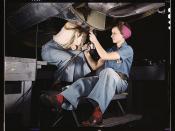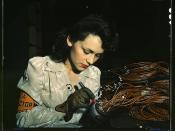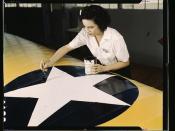EZ report, dumb topic Excellent report. Covered all areas.
How World War I and World War II influence fashion.
Wars and social changes brought the last radical the type of clothing that seemed appropriate. Since World War I and World War II, men and women's cloths have changed dramatically. The United States was one of the most involved countries in both of these wares. Industrial and social change was always around.
Women's clothes seen to have changed more during the time of war. A successful revolt by women against social and political restrictions led to the disappearance of physical restrictions of the corset. Almost for the first time in five centuries, the natural shape of women reappeared in clothing after World War I (1914-1919), as did the practice of revealing the legs. During World War I women were employed in factories, the wearing of long dresses became bothersome, so women's dresses started to become shorter.
They adopted the 'Boyish' look. Loose, unfitted skirts that fell just below the knee were popular. After World War I most clothes were being produced by mass production. Due to mass production, Women's fashions were changing more rapidly than ever. By the mid-1920s skirts had above the knee. By the 1930s women were wearing trousers
Men's clothing changed very little before and after war. Before World War I, double breasted and single breasted suits were popular. After was they sill were only know they became a little more radical. Solid color shirts in combination with wild ties accompanied their traditional suits. Out of work men's cloths became more durable. Sorts wear was the next popular style for the home environment
Since that time, almost any experiment in style has been labeled fashion. Industry, because of the war, had changed so they change everything with it.



Poorly written and lacking in depth.
Apart from practicality the reason women's skits got shorter were because of cloth shortages, full skirts were a waist of a precious resources. Be wary of concluding an essay with such vague comments that you provide no evidence for and contribute nothing to your argument.
11 out of 11 people found this comment useful.